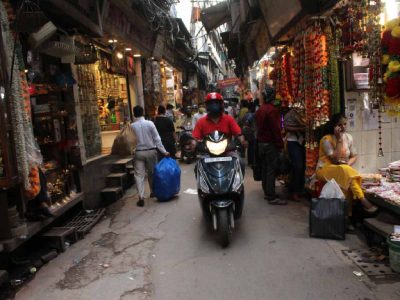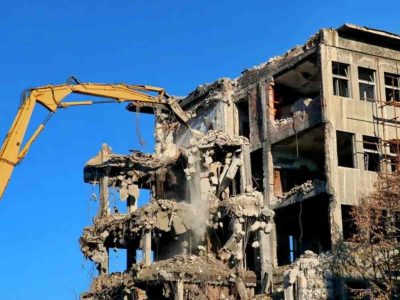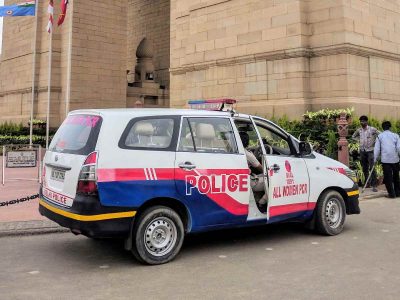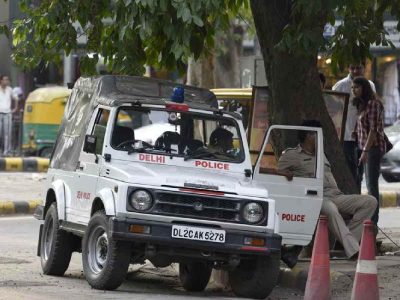Delhi’s once-vibrant markets, a bustling emblem of the city’s culture and economy, are gasping for breath as a thick, toxic smog blankets the streets. From the glittering bridal shops of Karol Bagh to the busy lanes of Lajpat Nagar, the impact of pollution is crippling. The familiar hum of bargaining, street food vendors, and everyday shoppers has dulled to a haunting silence. The wedding season, typically a time of frenzied shopping and gathering, has been overshadowed by a toxic haze that’s deterring people from stepping outside. While Chandni Chowk continues to pull in some visitors thanks to its historical allure, the grim reality cannot be ignored: Delhi’s markets are suffocating under the weight of pollution.
A desolate Karol Bagh
Karol Bagh, the beating heart of wedding shopping in Delhi, has been particularly hard-hit. The narrow streets once lined with bridal lehengas, sparkling jewellery, and designer wear now seem eerily empty. The wedding season at the busy marketplace, which normally sees hundreds of families browsing through the shops for hours, has seen a drastic decline in footfall.
Manoj Sharma, who has run his jewellery store for decades, laments, “This time of the year, our store would be full from morning till evening, with customers exploring and trying on collections. Now, they come, buy only what’s necessary, and leave immediately. The air quality has drained the life out of this market. It’s not just bad for business, it’s bad for our city.”
Suresh Gupta, who specialises in bridal wear, shares a similarly bleak outlook: “This should be our peak season, but sales have plummeted by nearly 50%. People are either opting to shop online or pushing back their purchases. The air outside is unbearable, and it’s affecting our sales and the whole festive atmosphere.”
Rakesh Kumar, a makeup shop owner, paints a grim picture: “I used to sell at least 100 items a day. Now, if I manage to sell 20, I consider myself lucky. People don’t want to spend time outdoors, and without foot traffic, my business is dying.”
Satinder Singh, General Secretary of the Gaffar Market Traders’ Association, reveals the gravity of the situation: “The situation is serious, we are living in a gas chamber and playing with the lives of older people. Footfall has decreased by 80% here in the Karol Bagh area. The roads are empty even during the wedding season. People are not coming to the markets because of air pollution; no one wants to roam around without reason. Even though the air is a bit clearer now, the problem of reduced footfall still persists.”
Lajpat Nagar fades
Lajpat Nagar, a bustling hotspot for trendy fashion and mouth-watering street food, has also seen a significant drop in foot traffic. Once filled with college students, families, and tourists, the market now feels like a shell of its former self. The usual winter rush, where people would browse for cosy clothes and enjoy spicy snacks, has been replaced by a dull, hurried pace.
Sunita Verma, an ethnic wear shop owner, describes the shift: “The celebratory spirit is completely missing. People used to linger, enjoying shopping with family. Now, they rush in, grab what they need, and leave. My sales have been halved compared to last year. It’s not just the weather; it’s the pollution that’s keeping people away.”
Ankur Mishra, who sells home decor, echoes the same concern: “The families that used to come here for home accessories, including young parents with children, are nowhere to be seen. They’re too afraid to step out in this smog. The air is choking, and it’s keeping everyone away. The market has seen a 60% drop in foot traffic over the past 15 days, and all of us are hoping for better sales before the wedding season ends.”
Even the market’s famed street food vendors are suffering. Sanjay, a popular golgappa vendor, used to see long lines of customers, but now his stall barely sees any foot traffic. “I used to sell 200 plates of golgappa a day. Now, I’m lucky if I sell 70-80. People prefer takeaways, avoiding the outdoor seating altogether. The air is too thick, and it’s affecting my sales.”
Chandni Chowk: The last stand
Despite the thickening smog, Chandni Chowk, the historic centre of Delhi, has managed to hold on to some footfall. With its centuries-old charm and necessity-driven shopping, the market hasn’t faced the same devastating decline seen in Karol Bagh and Lajpat Nagar. However, even this iconic bazaar can’t escape the smog’s suffocating grasp.
Rajesh Kalra, a lace and beads shop owner, shares his observations: “People still come to Chandni Chowk, but it’s more out of necessity than leisure. They know that some items can’t be found elsewhere, so they come with a list and leave quickly. There’s no more leisurely shopping or browsing. Even those who come wear masks and seem uncomfortable in the air.”
Amit Arora, a fabric dealer in Chandni Chowk, concurs: “The charm of this place is fading. People used to spend hours checking fabrics, discussing options. Now, they’re in and out, and many come wearing masks. The air quality is the elephant in the room, and it’s impossible to ignore.”
Mukesh Sachdeva, President of the Delhi Hindustani Mercantile Association, adds, “When the AQI hit over 400, we saw a sharp decline in footfall, even at Chandni Chowk. Retailers have faced huge losses. People who were supposed to shop for weddings are either shifting to online platforms or rushing through their shopping without taking their time. Even though things have improved slightly, foot traffic is still down by at least 50% compared to previous years.”
Vendors facing the heat
Street food vendors, who depend on the bustling crowds and the joy of people enjoying food outdoors, are facing a double blow. Not only are they worried about their health in such polluted conditions, but their income has taken a massive hit.
Naman, a pasta vendor in Karol Bagh, describes the fall in sales: “Evenings used to be our busiest time, but now my food is hardly moving. The students who loved my pasta are staying home, and I’m taking half of my food back home every night. People don’t want to sit outside and eat in this air.”
Rajiv Tiwari, who sells ram laddu in Lajpat Nagar, is feeling the pinch: “Winter used to be our prime season, especially with the cold weather and the craving for hot laddus. Now, no one wants to stay outside for too long. My business has taken a huge hit, and I’m struggling to make ends meet.”
Also Read: Suffering from toxic air, starved of learning: How school students are suffering in Delhi
Even momo vendors, once a favourite for quick bites, are facing reduced sales. Amarjeet Singh, a vendor near Lajpat Nagar Central Market, shares his frustration: “People used to crowd my stall, enjoying hot momos and chatting with friends. Now, they just grab their food and leave. Families aren’t coming with kids anymore, and that’s impacting sales.”
Hawkers: The hardest hit
Hawkers, who rely entirely on daily foot traffic, have been the hardest hit by the decline in market activity. Their survival is directly tied to the constant influx of customers, and without that, many are struggling to make a living.
Vijay Chauhan, who sells woollen scarves in Karol Bagh, laments: “This season is supposed to be our peak. With winter approaching, people usually buy scarves, stoles, and shawls. But now, no one’s coming. My sales are down by 70%, and I don’t know how I’ll survive this season.”

Deepak Yadav, a toy seller in Lajpat Nagar, shares a similar story: “Most of my customers are children, but parents aren’t bringing them out anymore. I used to sell at least 20 toys a day. Now, I’m lucky if I sell five. It’s devastating.”
Subhash Jha, who sells artificial jewellery, is feeling the weight of the downturn: “We rely on foot traffic for low-cost items, but now the market is dead. Without customers, I’m barely making enough to survive. Every day feels like a struggle.”
As Delhi’s markets continue to battle this invisible enemy of pollution, the future remains uncertain. Shopkeepers, hawkers, and street vendors are left to navigate the thick smog, hoping for a change in the weather and a return to the vibrant life they once knew. The air may be clearer at times, but the shadow of reduced footfall looms over the city’s beloved markets.





